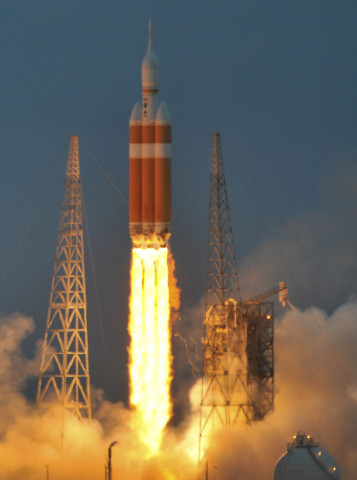NASA's Orion capsule blasts off on 'first step' to Mars
Space capsule meant to carry humans to deep space destinations like Mars in the coming years

The unmanned spacecraft soared to space at 7:05am atop a United Launch Alliance Delta IV Heavy rocket that rumbled and roared as it climbed above the Florida coast at sunrise.
"I think it's a big day for the world, for people who know and love space," said Nasa administrator Charles Bolden.
The four-and-a-half hour flight aims to test crucial systems like the heat shield and parachute splashdown.
The launch is the first in more than 40 years of a US spacecraft intended to carry humans beyond the Moon. It has reinvigorated a US human exploration program that has been stagnant for more than three years since the last American space shuttle carried a crew of astronauts to the International Space Station.
The 30-year shuttle program ended in 2011, leaving the United States no other option but to pay Russia to carry astronauts on its Soyuz capsules at a cost of $71 million per seat.
Friday's launch attempt aims to propel the Orion capsule into two loops around the Earth.
The first orbit is to be about as high as the International Space Station, which circles at an altitude of about 270 miles, but the second would soar 15 times higher, to an apogee of 3,600 miles above the Earth.
Then, the spacecraft is supposed to plunge into the waters off San Diego, California to be retrieved by the US Navy.
An analysis of sophisticated sensors on the capsule should let Nasa know if the temperature inside remained survivable for a potential crew, even as the spacecraft's exterior heated to 4,000 degrees Fahrenheit during its re-entry to Earth's atmosphere at a velocity of 20,000 miles per hour.
Potential future missions for Orion, which can fit four people at a time, include a trip to lasso an asteroid and a journey to Mars by the 2030s.
Nasa has already spent $9.1 billion on Orion and the powerful rocket meant to propel it with crew on board, the Space Launch System (SLS).
Another unmanned test flight is slated for 2018. The first Orion test flight with people on board is scheduled for 2021, when total costs are projected to reach $19-22 billion.
About $370 million dollars in equipment is at stake in Friday's launch.



















COMMENTS
Comments are moderated and generally will be posted if they are on-topic and not abusive.
For more information, please see our Comments FAQ